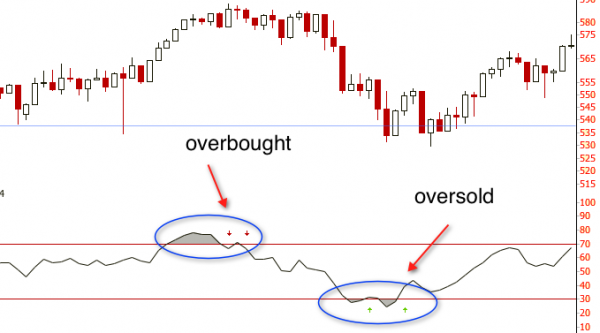RSI Technical Indicator for Stock and Share Trading
Post on: 2 Июль, 2015 No Comment

Stock and Share Trading
When applied to stocks, shares and securities, RSI stands for Relative Strength Index. It was originally developed by J. Welles Wilder, Jr, who first introduced the concept of RSI to the world in his 1978 book, New Concepts in Technical Trading Systems.
Unfortunately there are two different types (and meanings) of Relative Strength when it comes to stock market trading, and this fact can lead to possible confusion. One of the types of Relative Stength is the type used to compare the performance of a particular stock with another stock or sector of the market, or with the whole market itself, or even to compare whole markets worldwide (for example to compare the relative performance of the UK Stock Market in comparison to the USA stock market). This type is not what will be discussed on this page, but instead the Relative Strength Index developed by J. Welles Wilder Jr is a momentum oscillator which is based purely on the price changes of a single particular stock, share or security, and does not compare that individual stock to others or to a sector or the market as a whole.
Adding up all of the positive changes gives 14.8+0.5+2.5+2.5+4.25+3. Which is a total of 27.55. We now need to divide this up total by the number of days in our period. in other words, in our example we need to calculate 27.55ч14. This gives us an average up price change of 1.9678571428571428571428571428571.
Now, a similar calculation needs to be done with all the negative changes which occurred during the period. We need to ignore the negative sign when doing this calculation, so the total is 7+1.3+15+3.25+1+1+1, giving a result of 29.55. Similar to the up total, we need to divide this down total by the number of days in our period. So, using our 14 day period, we calculate 29.55ч14, which gives an average down price change of 2.1107142857142857142857142857143.
Once we’ve got the average up price change and the average down price change. we can calculate the RS. which is the Relative Strength. not yet the RSI but we’re getting nearer! The RS is the average up price change divided by the average down price change. So in our example the RS is 1.9678571428571428571428571428571 ч 2.1107142857142857142857142857143, giving a RS value of 0.93231810490693739424703891708974.
Finally we can now apply the final calculation:
RSI = 100 — (100ч(1+ RS ))
Which gives, in our example, an RSI of 100 — (100ч(1+0.93231810490693739424703891708974)), which is 48.248686514886164623467600700507.

RSI interpretation
The RSI is a momentum oscillator, which measures the speed of directional price movement. According to Wilder, a divergence between the RSI and price action on the chart is a very strong indication that a market turning point is imminent. A divergence between the RSI and stock price action is where the sctock is making new highs and the RSI is making new lows (or vice-versa).
RSI can also be used to identify when a stock or share is overbought or oversold. With a 14 day period RSI, many analysts consider that if the RSI drops to below 30 mark, it indicates that the stock is oversold, so is a possible buy signal. Converssely, if the RSI rises to above 70, the stock may be overbought and it is worth considering selling. If a shorter period (for example 8 days) is used, you may wish to use a lower level (for example 20 to 25) as an oversold level, and a higher level (eg 75 to 80) as an overbought indicator. The lower number of days used for the period. the more volatile the RSI will be.
Overall, RSI is one of the most popular technical indicators, and analysts consider it to be among the most reliable. However, it works best with volatile shares, and may not provide as much success if used with shares whose price does not change much over time. Also, beware of large surges and drops in stock or share values — such sudden movements may produce a false buy or sell signal. It is best to use RSI as a compliment to your investing tools and information, rather than simply on its own.














